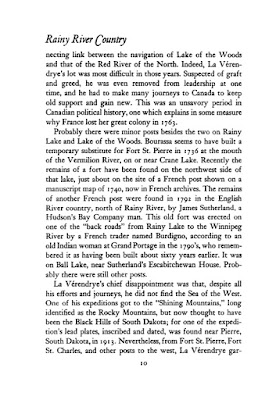Voyageurs National Park is named for the French-Canadian fur traders of the 17th through 19th centuries. Their canoe route was known as “Voyageurs Highway,” and now defines the border between the US and Canada.
From the National Park Service…
The voyageur - a French word meaning traveler - the namesake of Voyageurs National Park - began journeying through these interconnected waterways over 250 years ago; waterways that are one of the most important segments of the fur trade route used to open the "Great Northwest".
As park visitors travel the lakes today, it is easy to imagine the voyageurs of the past dipping their canoe paddles into the clear, dark waters to the rhythm of their songs, gliding past the rock and pines of this northern landscape.
Voyageurs National Park was established in 1975, but is filled with evidence of over 10,000 years of human life and use. Signs of Native Americans, fur traders, and homesteaders, signs of logging, mining, and commercial fishing are scattered throughout the park.
The Organic Act of 1916 created the National Park Service and decreed that nature and culture were to be protected hand-in-hand. Voyageurs National Park protects and shares a rich, unique cultural history that was shaped by the picturesque, rugged nature of its water and lands.
Voyageurs
The earliest European exploration of this area is believed to have occurred about 1688 when French explorer Jacques de Noyon wintered along the Rainy River.
The European demand for beaver pelts brought fur traders into the region. The voyageurs paddled large birch bark canoes carrying trade goods and furs between the Canadian northwest and Montreal. The voyageurs were prompted by competition over the diminishing supply of furs in the east, and were the first Europeans to explore the northwest territory and to engage the indigenous peoples in the trade of furs on a commercial scale.
The Cree, Monsoni, and Assiniboin tribes were the primary inhabitants of the region at the time of initial European contact. However, by the mid-18th century they had largely abandoned the Rainy Lake area, leaving the region open for settlement by the Ojibwe.
 |
| Wolf on Rainy Lake. Image from anglerinsider.com |
By 1780 the Ojibwe had become the primary residents of the border lakes region, and they played a key role in commerce as suppliers of food, furs, and canoes. They were also guides during the fur trade, their intimate knowledge of the geography and resources was crucial to the European fur traders.
Genealogy
A few of my voyageur ancestors, who I know, passed through Rainy Lake (French: Lac La Pluie) include (with links to their stories):
Rene Bourassa dit LaRonde (1688-1778) (6th great-uncle) https://a-drifting-cowboy.blogspot.com/2015/08/great-uncle-rene-was-coureurs-des-bois.html
Charles Boyer (1713-1801) (8th great-uncle) http://laprairie-voyageur-canoes.blogspot.com/2017/03/ripples-from-la-prairie-voyageur-canoes_62.html
Charles Mignier dit Lagace (Lagasse) (1744-1819) (6th great-uncle) https://a-drifting-cowboy.blogspot.com/2016/08/uncle-charles-lagasse-on-columbia.html
Charles Boyer (1744-_) (1st cousin 8x removed) https://a-drifting-cowboy.blogspot.com/2016/06/cousin-charles-boyer-was-norwester.html
 |
|
1797, NWCo engagement of Joseph Vielle dit Cossé
|
François Rivet (1754-1852) (2nd cousin 7x removed) https://a-drifting-cowboy.blogspot.com/2016/08/cousin-francois-rivet-mountain-man.html
Pierre Pinsonneau (1765-1826) (5th great-uncle) https://a-drifting-cowboy.blogspot.com/2016/08/uncle-pierre-norwester-goes-to-portage.html
Joseph Vielle dit Cosse (1767-_) (5th great-uncle) https://a-drifting-cowboy.blogspot.com/2016/08/great-uncle-joseph-nwc-voyageur-who.html
Andre Mignier dit Lagasse (Lagace) (1775-_) (1st cousin 6x removed) https://a-drifting-cowboy.blogspot.com/2016/08/cousin-andre-lagasse-was-interpreter.html
Michel Vielle dit Cossé (1771-1810) (5th great-uncle) http://laprairie-voyageur-canoes.blogspot.com/2017/03/ripples-chapter-three-vielle-family.html
Francois Pinsonneau (1777-1846) (5th great-uncle) http://laprairie-voyageur-canoes.blogspot.com/2017/03/ripples-chapter-three-pinsonneau-family.html
Jean-Baptiste Meunier (Mignier, Minier) Lagasse (Lagace) (1776-1835) (4th great-grandfather & Lucy Pinsonneau's grandfather) https://a-drifting-cowboy.blogspot.com/2017/01/great-grandfather-canoes-to-lac-le-pluie.html
Reasons and goals
I’m in my 76th year on planet earth, and my most memorable wilderness experience was more than 30 years ago when I spent just over a week exploring Minnesota’s Boundary Waters Canoe Area Wilderness. Being a native Californian I had never experienced anything like it.
The boreal forest of the Northwoods is unlike our rugged Sierra Nevada Mountains. I had never before heard loons calling, had a moose swim across a lake in front of me, while an eagle soared overhead, and caught walleye, northern pike, and lake trout, before making camp under an incredible milky-way lighted sky.
I want to experience those things one last time before I cross over the Great Divide, and I want to say I’ve canoed the same lakes my voyageur ancestors paddled 200 years before.
On Crane Lake I plan to paddle into the mouth of the Vermilion River where Rene Bourassa (6th great-uncle) built his trading post in 1736.
 |
| Page from Grace Nute's "Rainy River Country" |
To learn more about my voyageur ancestors see my collection of essays and family histories of the voyageur ancestors of Lucy Pinsonneau (Passino) (1836–1917), my 2nd great-grandmother. This collection covers more than 100 ancestors, from over 25 families, that were engaged in the fur trade between the 1620s and 1840s in New France and later Canada.
Maybe one of your ancestors is listed here…
I just purchased a new Sports Action Camera, and I hope to share some great photos and video when I return.
I'm experimenting with the remote which will allow me to switch from photos to video while paddling a canoe on Rainy Lake and Crane Lake.
THE TRIP:
Genealogy Roadtrip to Voyageurs National Park - Goals
Genealogy Roadtrip to Voyageurs National Park - Part II
Genealogy Roadtrip to Voyageurs National Park - Part III
Genealogy Roadtrip to Voyageurs National Park - Part IV
My 1986 BWCAW trip slideshow... https://www.youtube.com/watch?v=X0RwnkeRtZM









